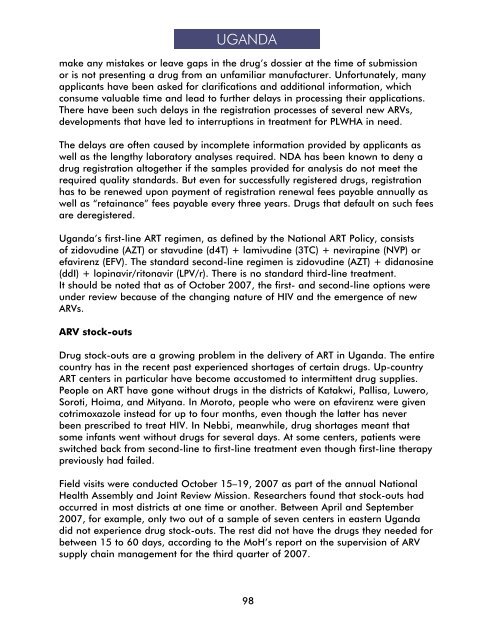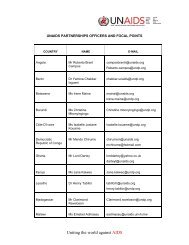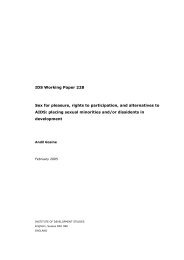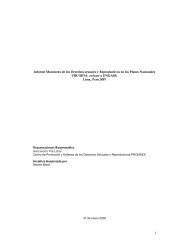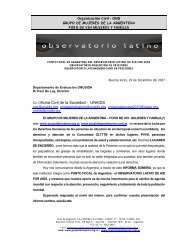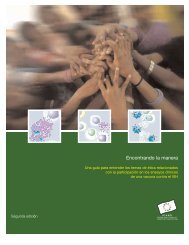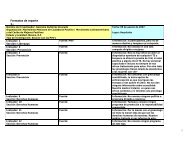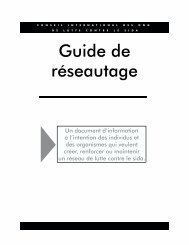Missing the Target #5: Improving AIDS Drug Access ... - CD8 T cells
Missing the Target #5: Improving AIDS Drug Access ... - CD8 T cells
Missing the Target #5: Improving AIDS Drug Access ... - CD8 T cells
Create successful ePaper yourself
Turn your PDF publications into a flip-book with our unique Google optimized e-Paper software.
make any mistakes or leave gaps in <strong>the</strong> drug’s dossier at <strong>the</strong> time of submissionor is not presenting a drug from an unfamiliar manufacturer. Unfortunately, manyapplicants have been asked for clarifications and additional information, whichconsume valuable time and lead to fur<strong>the</strong>r delays in processing <strong>the</strong>ir applications.There have been such delays in <strong>the</strong> registration processes of several new ARVs,developments that have led to interruptions in treatment for PLWHA in need.The delays are often caused by incomplete information provided by applicants aswell as <strong>the</strong> lengthy laboratory analyses required. NDA has been known to deny adrug registration altoge<strong>the</strong>r if <strong>the</strong> samples provided for analysis do not meet <strong>the</strong>required quality standards. But even for successfully registered drugs, registrationhas to be renewed upon payment of registration renewal fees payable annually aswell as “retainance” fees payable every three years. <strong>Drug</strong>s that default on such feesare deregistered.Uganda’s first-line ART regimen, as defined by <strong>the</strong> National ART Policy, consistsof zidovudine (AZT) or stavudine (d4T) + lamivudine (3TC) + nevirapine (NVP) orefavirenz (EFV). The standard second-line regimen is zidovudine (AZT) + didanosine(ddI) + lopinavir/ritonavir (LPV/r). There is no standard third-line treatment.It should be noted that as of October 2007, <strong>the</strong> first- and second-line options wereunder review because of <strong>the</strong> changing nature of HIV and <strong>the</strong> emergence of newARVs.ARV stock-outsUGANDA<strong>Drug</strong> stock-outs are a growing problem in <strong>the</strong> delivery of ART in Uganda. The entirecountry has in <strong>the</strong> recent past experienced shortages of certain drugs. Up-countryART centers in particular have become accustomed to intermittent drug supplies.People on ART have gone without drugs in <strong>the</strong> districts of Katakwi, Pallisa, Luwero,Soroti, Hoima, and Mityana. In Moroto, people who were on efavirenz were givencotrimoxazole instead for up to four months, even though <strong>the</strong> latter has neverbeen prescribed to treat HIV. In Nebbi, meanwhile, drug shortages meant thatsome infants went without drugs for several days. At some centers, patients wereswitched back from second-line to first-line treatment even though first-line <strong>the</strong>rapypreviously had failed.Field visits were conducted October 15–19, 2007 as part of <strong>the</strong> annual NationalHealth Assembly and Joint Review Mission. Researchers found that stock-outs hadoccurred in most districts at one time or ano<strong>the</strong>r. Between April and September2007, for example, only two out of a sample of seven centers in eastern Ugandadid not experience drug stock-outs. The rest did not have <strong>the</strong> drugs <strong>the</strong>y needed forbetween 15 to 60 days, according to <strong>the</strong> MoH’s report on <strong>the</strong> supervision of ARVsupply chain management for <strong>the</strong> third quarter of 2007.98


